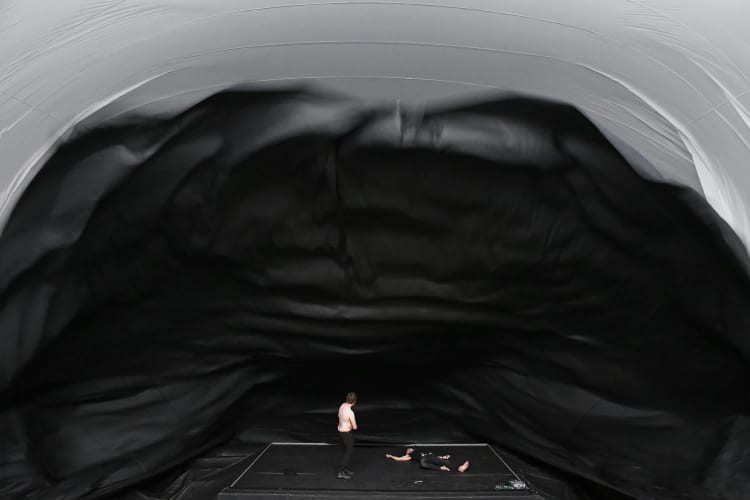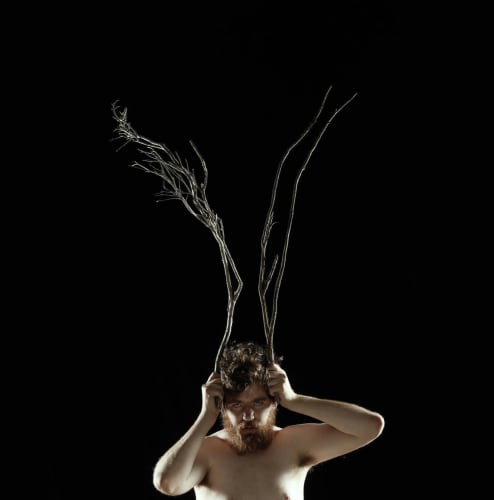Back to Back Theatre is an Australian company from Geelong that is an ensemble of six actors, all of whom are disabled or non-neurotypical. They focus on design, light and sound and make work that they say “questions the assumptions of what is possible in theatre [and] also the assumptions we hold about ourselves and others."
This production, the fourth by the company that the Barbican has brought to London, is presented as part of the Barbican’s The Art of Change season and of LIFT 2018. It premièred in Melbourne in 2016 but, though its outline is similar, it arrives in London with cast changes and some redevelopment.
Lady Eats Apple certainly offers something very different from usual expectation of theatrical entertainment. To begin with, there’s where and how the audience see it. Though the ticket says Stalls, instead of going into the auditorium they are led down a dog’s leg turn of the stair and through a pass door to backstage. Channelled by black walls, they must squeeze through a huge plastic vagina and then find they are in a huge cave of black plastic.
In the half-light, a couple of blokes are hanging around chatting on a small raised stage in front of banked seating. During the long wait for all to file in, there is plenty of time to discover the headphones for each place. At last, a projected text gives instructions to put on headphones. “Relax, we will look after you,” a voice tells us with surtitles now supplementing dialogue as the first scene of this four-part performance commences. It is called “Out with the old and in with the new.”
What is happening? A man in a suit holds up drawings of animals for the young bearded man to identify. His speech may be fragmented but he gets things right and seems to gain approval, but then he protests at the patronising attitude declaring “I’m not stupid.” But this isn’t just about attitudes to disability and the title is the obvious clue. This isn’t identification it is naming: “In the Beginning was the Word.” It is God doing His naming and the other figure is the Old God whom He is soon supplanting.
With the creation of Adam and then Eve, who appear in live form in God’s likeness, differently abled, the story continues, humankind eating the (drawn) apple and the Old God, feeling his existence now has no point, asking the new God to kill him.
With Adam and Eve expelled from Eden by a bellowing God, He triggers the black cave to vanish leaving a white one that contained it then, as darkness envelops all, the second part of the performance begins: “A near-death experience”.
The audience sit in the dark listening to a score resonating with the sound of tubular bells and light tintinnabulations as a faint moiré pattern moves across the roof of the cave, eventually replaced by what may be cloud formations. Is this earth seen from space, the moon's surface? Black clouds congeal as the music turns into a roar, then there is the glow of multiple orange lights before it all disappears.
Part three: “All we have is the human bond,” reveals the Barbican auditorium, with performers as cleaners vacuuming and bagging litter. The Old God still lies dead below them. It explores the limitations others put on the expectations of those who are disabled and then with a frankness that is delicately presented shows a budding sexual relationship, which has just been warned against. The actors are far away in an upper gallery, but in the ears their voices are up-close and intimate.
When they have left the auditorium, the last part begins on stage with the God actor, who perhaps is now just another man, and the other performers discovering the body lying there and trying to bring it back to life. God soon gives up but the humans go on trying.
In 75 minutes, Lady Eats Apple goes through a reversed birth back to creation and through life’s aspirations to death, however you approach it. It makes its points about attitudes to disability very clearly but its more mystical ideas and consideration of mortality aren’t conveyed so effectively, though the concentrated energy of the performers is impressive.
It relies too much on the effect of its dislocation of audience expectation which won’t be so surprising to those used to productions on the international festival circuit and doesn’t offer clear enough content.

